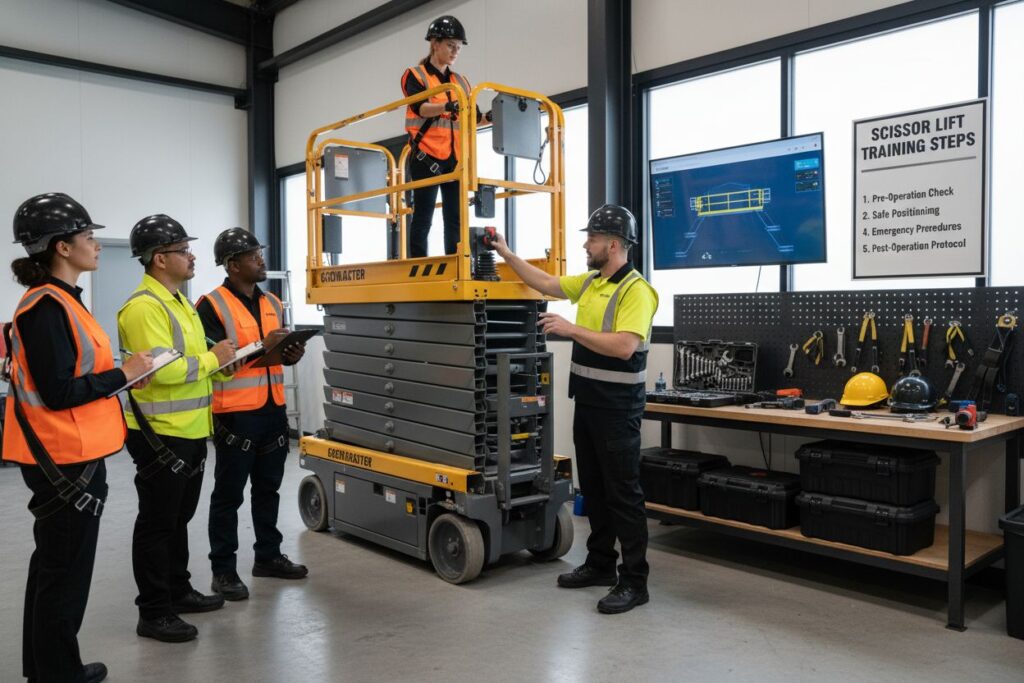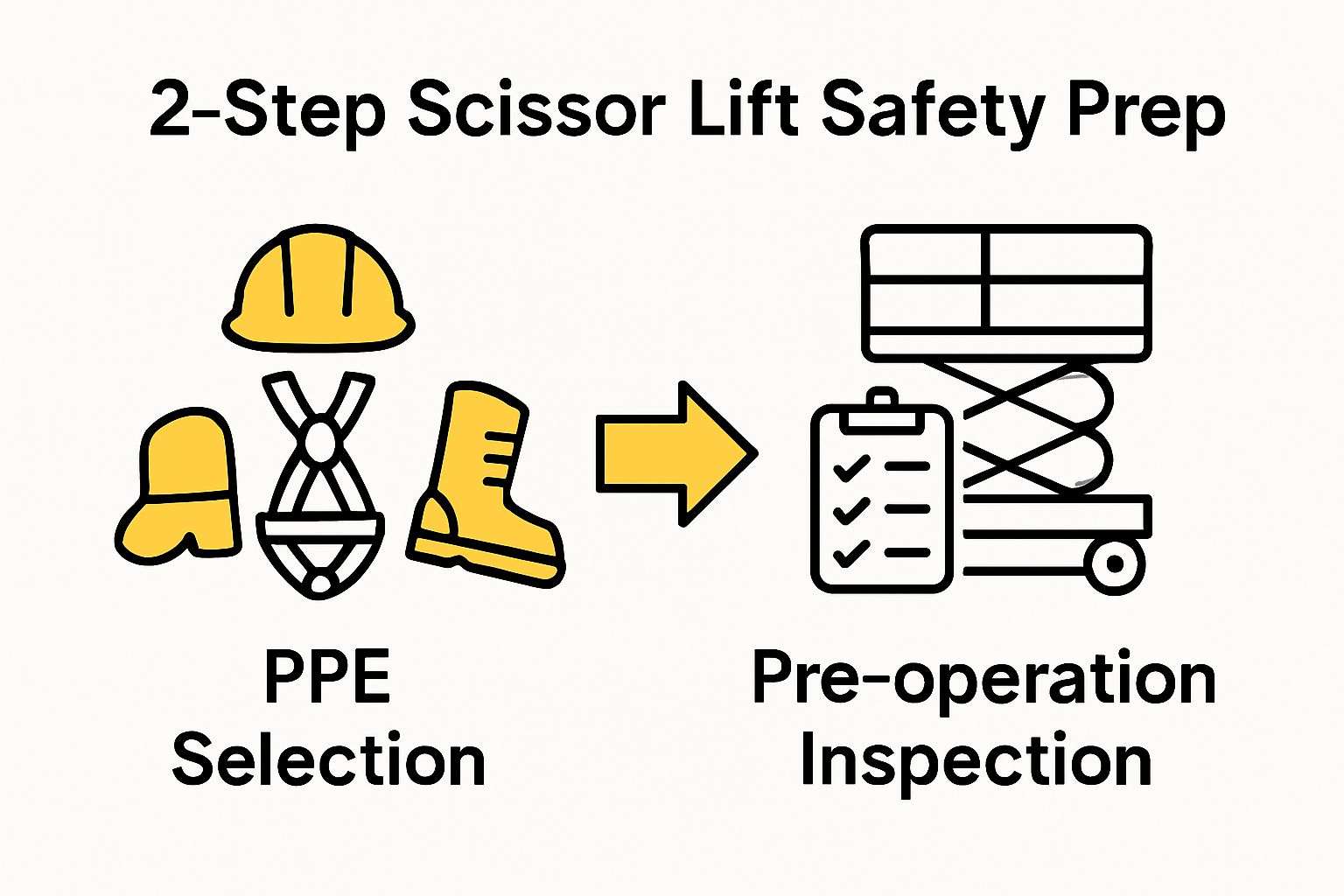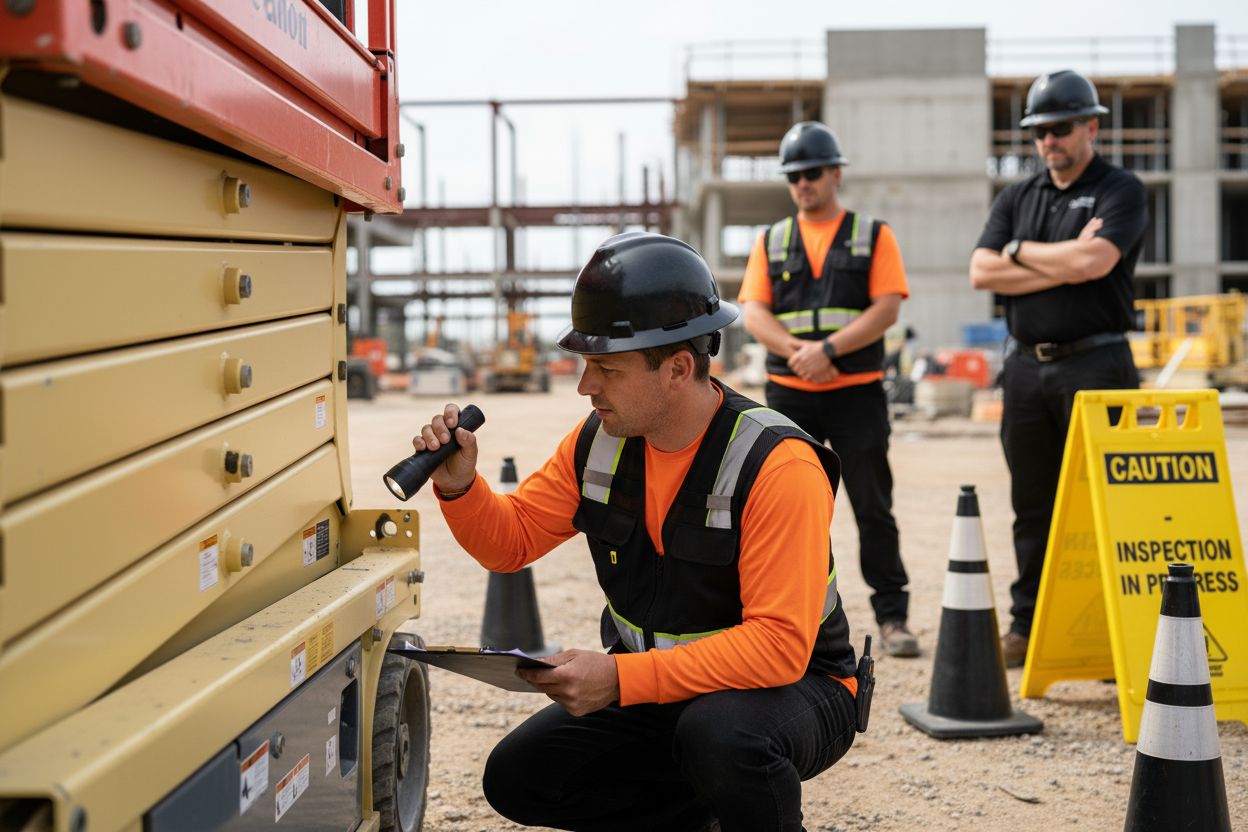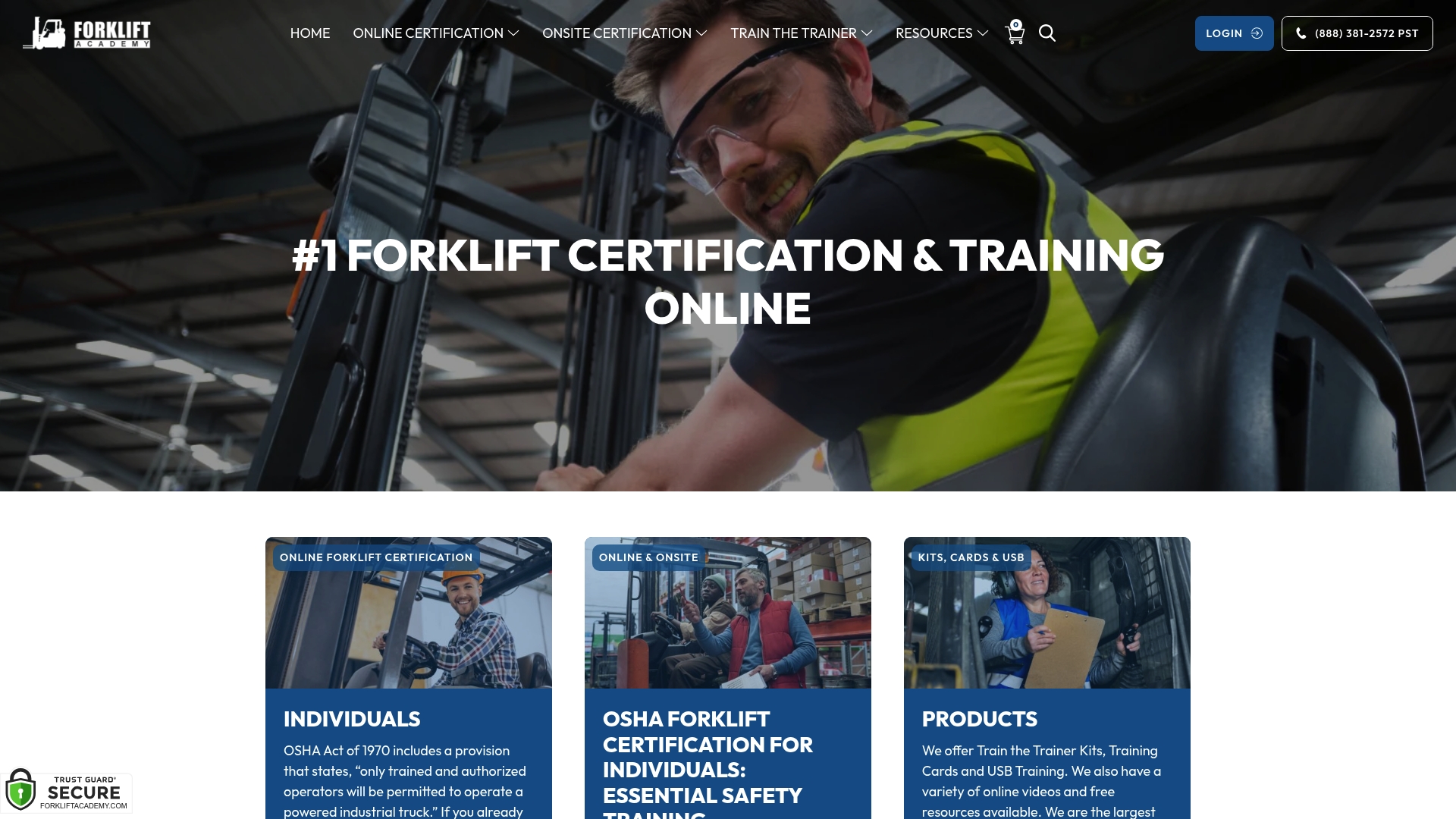
Scissor lifts keep workers elevated and job sites efficient and they look simple to use at first glance. But accidents involving aerial lifts cause over 20 fatalities and 1,500 serious injuries each year in the US alone. Most people only focus on what happens after you step on the platform but the real protection starts way before you even power up the lift.
| Key Point | Explanation |
|---|---|
| 1. Conduct a thorough safety assessment | Identify potential hazards and establish prevention strategies to protect workers and equipment before using scissor lifts. |
| 2. Select appropriate personal protective equipment | Ensure the PPE fits correctly and is suitable for potential hazards like falls or flying debris during operations. |
| 3. Perform pre-operation equipment inspections | Check structural components and safety mechanisms to verify the scissor lift is in safe operating condition before use. |
| 4. Establish clear communication protocols | Ensure operators maintain effective communication with ground personnel to manage safety during lift operations. |
| 5. Verify operator competence through practical testing | Operators must demonstrate their skills and knowledge in realistic scenarios, including emergency responses, before being authorized to operate equipment. |
Assessing workplace safety requirements forms the critical foundation for safe scissor lift operations. Before any worker steps onto a scissor lift platform, a comprehensive safety evaluation must occur to identify potential hazards and establish robust prevention strategies. This initial assessment protects workers, equipment, and the overall operational environment.
The assessment process begins with a thorough examination of the specific work environment. Safety professionals and authorized personnel must systematically review the physical workspace, including floor conditions, overhead obstacles, electrical lines, ventilation systems, and potential obstructions that could impact scissor lift movement. Understanding workplace safety protocols requires meticulous attention to detail and proactive risk management.
Critical components of the workplace safety assessment include evaluating ground surface stability, checking for uneven terrain, identifying potential overhead clearance limitations, and assessing environmental conditions such as wind speed, temperature, and moisture levels. Operators must verify that the selected work area can safely support the scissor lift’s weight and operational requirements. This means measuring load-bearing capacities, examining surface compaction, and ensuring no hidden underground utilities or structural weaknesses could compromise equipment stability.
Documentation plays a crucial role in this assessment phase. Safety managers must create comprehensive written records detailing every identified risk, potential mitigation strategy, and specific site conditions. These documents serve multiple purposes: they provide a clear reference for operators, demonstrate regulatory compliance, and establish a baseline for ongoing safety monitoring. Detailed assessment documentation should include precise measurements, photographic evidence, and explicit recommendations for safe equipment deployment.
The final verification step involves conducting a practical site walkthrough with trained safety personnel. This physical inspection allows for real-time risk identification that might not be apparent through theoretical assessment. Operators should walk the entire work area, mark potential hazard zones, and develop specific operational guidelines tailored to the unique environmental challenges present. By combining systematic documentation with hands-on evaluation, organizations can create a robust safety framework that minimizes potential workplace incidents and protects worker wellbeing.
Selecting the right personal protective equipment (PPE) represents a critical safety measure for scissor lift operators, serving as the primary defense against potential workplace injuries. This step goes beyond simply choosing protective gear it requires a strategic approach that matches specific equipment and environmental conditions to comprehensive safety requirements.
The PPE selection process begins with understanding the unique characteristics of the work environment and potential hazards. According to workplace safety guidelines, operators must consider factors like electrical risks, potential falling object dangers, surface conditions, and height-related exposure. Full-body harnesses become mandatory when working at elevations exceeding six feet, providing critical fall protection that prevents catastrophic injuries.
Operators must carefully evaluate specific PPE components to ensure maximum protection. Hard hats protect against overhead impacts and falling objects, while safety glasses with side shields guard against flying debris and potential eye injuries. Steel-toed boots with slip-resistant soles provide crucial ground-level protection, helping prevent foot injuries and maintaining stable footing during scissor lift operations. Work gloves designed for specific tasks offer hand protection against abrasions, cuts, and potential chemical exposures.
Beyond standard protective gear, specialized equipment might be necessary depending on work conditions. Respiratory protection becomes essential when operating in environments with airborne particulates, chemical vapors, or dust. High-visibility vests ensure workers remain easily identifiable in complex industrial settings, reducing the risk of accidental contact with moving machinery or other workers. Temperature-specific protective layers like insulated jackets or cooling vests might also be required for extreme working conditions.
The final verification of PPE selection involves a comprehensive equipment inspection and fit check. Each piece of protective gear must be examined for structural integrity, proper sizing, and compatibility with other safety equipment. Operators should perform physical tests to confirm that selected PPE allows full range of motion while providing maximum protection.
Use this table to quickly review common types of personal protective equipment (PPE) required for scissor lift operations, including their safety functions and key considerations for selection.
| PPE Type | Safety Function | Selection Considerations |
|---|---|---|
| Full-Body Harness | Prevents falls from elevated platforms | Mandatory above six feet |
| Hard Hat | Protects against falling objects/impacts | Check fit and impact resistance |
| Safety Glasses | Shields eyes from flying debris | Must have side protection |
| Steel-Toed Boots | Guards feet and improves stability | Slip-resistant soles, proper sizing |
| Work Gloves | Protects hands from cuts, abrasions, and chemicals | Select based on specific task hazards |
| High-Visibility Vest | Enhances worker visibility near machinery | Use in busy or low-light environments |
| Respirator | Protects from airborne contaminants/dusts | Required in dusty or chemical-heavy areas |
 This means checking harness attachments, testing glove flexibility, ensuring clear visibility through safety glasses, and confirming that protective clothing does not restrict movement or create additional safety risks during scissor lift operations.
This means checking harness attachments, testing glove flexibility, ensuring clear visibility through safety glasses, and confirming that protective clothing does not restrict movement or create additional safety risks during scissor lift operations.
Pre-operation equipment inspections represent a crucial safety protocol that prevents potential accidents and ensures optimal scissor lift performance. This systematic evaluation serves as the critical interface between equipment readiness and operator safety, requiring meticulous attention to detail and comprehensive mechanical assessment.
Operators must begin the inspection process by performing a comprehensive visual examination of the entire scissor lift system. Understanding workplace safety protocols emphasizes the importance of a thorough initial assessment. Inspect the lift’s structural components, including welds, structural framework, platform guardrails, and hydraulic systems for any signs of damage, corrosion, or structural weakness. Pay close attention to potential stress points, checking for hairline cracks, excessive wear, or unusual deformations that might compromise equipment integrity.
The mechanical inspection extends beyond visual assessment to include functional testing of critical safety mechanisms. Operators must systematically verify the operational status of emergency stop buttons, platform controls, stabilization systems, and mechanical locking components. This involves testing each control mechanism through a complete range of motion, confirming smooth operation without unexpected resistance or unusual sounds. Hydraulic systems require special scrutiny, checking for fluid leaks, proper pressure levels, and smooth extension and retraction of lifting mechanisms.
Tire and wheel conditions demand particular attention during pre-operation inspections. Examine tire treads for uneven wear, potential damage, and appropriate inflation levels. Verify that wheel locks and stabilization systems function correctly, ensuring the scissor lift can maintain stable positioning across various surface conditions. Operators should also check battery connections, electrical systems, and control panel indicators to confirm all electronic components are functioning properly.
The final verification stage involves comprehensive documentation and immediate reporting of any discovered issues. Create a detailed inspection log that records every observed condition, noting potential concerns or required maintenance. Any identified problems must be immediately reported to supervisory personnel and addressed before equipment operation.
Below is a checklist table to help you verify that all necessary pre-operation equipment checks for scissor lift safety are completed before use.
| Inspection Item | What to Check For | Action Required if Issue Found |
|---|---|---|
| Structural Components | Cracks, corrosion, frame and weld integrity | Report and do not operate until fixed |
| Platform Guardrails | Stability, damage, missing or loose sections | Report and repair before operation |
| Hydraulic Systems | Leaks, proper pressure, smooth movement | Service hydraulics before using lift |
| Emergency Stop Buttons | Function across all controls | Repair immediately if not working |
| Wheels and Tires | Tread wear, inflation, locks functionality | Replace or repair as needed |
| Battery and Electrical Systems | Secure connections, indicator function | Charge, replace, or service system |
| Control Panels | All controls operate smoothly, no unusual sounds | Service controls prior to operation |

Executing safe operating procedures forms the core of responsible scissor lift operation, transforming theoretical knowledge into practical safety protocols. This critical step demands unwavering attention, precise technical skill, and a comprehensive understanding of equipment capabilities and environmental limitations.
Understanding OSHA compliance guidelines emphasizes the importance of methodical operational approach. Operators must begin by establishing a clear communication protocol with ground personnel, ensuring constant awareness of surrounding work environments. This means maintaining direct visual contact with support team members, using standardized hand signals, and establishing clear verbal communication channels before initiating any lift movement.
The actual operational process requires meticulous positioning and stabilization of the scissor lift. Operators must carefully select a level surface with sufficient load-bearing capacity, using outriggers or stabilization mechanisms to create a solid foundation. Precise platform positioning is critical, which involves calculating precise distance from work surfaces, overhead obstacles, and potential interference zones. Operators should maintain a minimum safe distance from electrical lines, structural elements, and other potential hazards, continuously scanning the entire operational environment.
Managing platform elevation demands exceptional spatial awareness and controlled movement. Operators must execute smooth, deliberate movements, avoiding sudden shifts or jerky motions that could compromise lift stability. Weight distribution becomes paramount during elevated operations, requiring operators to remain centrally positioned and avoid leaning beyond platform guardrails. All tools and equipment should be securely fastened, preventing potential falling object hazards that could endanger ground personnel or damage surrounding infrastructure.
The final verification of safe operating procedures involves continuous risk assessment and immediate corrective action. Operators must remain vigilant, monitoring equipment performance, environmental conditions, and potential emerging hazards throughout the operational cycle. Any detected anomalies or unexpected environmental changes should trigger an immediate pause in operations, followed by a comprehensive reassessment of safety parameters. By maintaining a proactive, disciplined approach to scissor lift operation, workers can significantly reduce workplace accident risks and create a culture of safety that protects both individual operators and surrounding team members.
Practical testing represents the ultimate validation of scissor lift operator competence, transforming theoretical knowledge into demonstrable workplace safety skills. This critical evaluation phase goes beyond simple performance assessment, serving as a comprehensive measurement of an operator’s ability to apply safety protocols under realistic working conditions.
Workplace safety best practices underscore the importance of structured skill verification. The practical testing process must simulate actual work environments, presenting operators with realistic scenarios that challenge their technical knowledge, decision-making abilities, and safety awareness. Authorized evaluators design comprehensive test scenarios that incorporate multiple complex variables, including equipment operation, environmental challenges, emergency response protocols, and precise mechanical manipulation.
The testing framework requires operators to demonstrate proficiency across several critical skill domains. This includes precise scissor lift positioning, smooth operational control, accurate height management, and immediate recognition of potential safety risks. Operators must showcase their ability to perform equipment inspections, utilize personal protective equipment correctly, and execute controlled movements with minimal mechanical strain. Evaluators pay close attention to operators’ spatial awareness, reaction times, and ability to maintain composure under simulated stress conditions.
Emergency response capabilities form a crucial component of practical testing. Operators must convincingly demonstrate their capacity to handle unexpected scenarios such as sudden mechanical failures, environmental disruptions, or potential worker safety incidents. This involves executing proper shutdown procedures, communicating effectively with ground personnel, and implementing emergency protocols with calm, methodical precision. Evaluators specifically assess an operator’s capacity to recognize potential hazards quickly and implement appropriate corrective actions without hesitation.
The final verification involves comprehensive documentation and skill assessment scoring. Each tested operator receives a detailed performance evaluation that identifies strengths, potential improvement areas, and specific recommendations for further training. Successful completion requires meeting or exceeding predefined performance standards that align with industry safety regulations. Operators who do not meet these rigorous standards must undergo additional training and re-testing, ensuring that only fully competent professionals are authorized to operate scissor lift equipment in workplace environments.
Are you concerned about meeting strict safety requirements or worried that missed steps in training might put your team at risk? If you want to avoid costly citations and the danger of workplace accidents, complete mastery of the essential scissor lift training steps is non-negotiable. Following clear protocols, using the right personal protective equipment, and verifying hands-on skills are key, but staying current can feel overwhelming. Explore expert guidance and solutions in our Forklift Safety Archives and see how you can build a safer work environment.

Do not leave safety to chance when you have direct access to OSHA-compliant scissor lift and forklift certification at your fingertips. Visit Forkliftacademy.com to enroll in online or onsite training. You will discover a full menu of forklift license and certification resources that support your compliance journey and workforce safety. Take the next step now to protect your people and your business.
To begin assessing workplace safety, conduct a thorough examination of the work environment, looking for potential hazards such as overhead obstacles and uneven surfaces. Document the findings and develop a risk mitigation plan before allowing any workers on the scissor lift.
Select personal protective equipment (PPE) based on the specific hazards present in your work environment, such as hard hats for overhead risks and full-body harnesses for heights over six feet. Ensure all PPE fits properly and allows for full range of motion during operations.
During pre-operation inspections, include a comprehensive visual and mechanical assessment of the scissor lift, checking for structural integrity, tire conditions, and the operational status of safety mechanisms. Document any issues found and report them to supervisory personnel before starting the lift.
Key safe operating procedures involve establishing clear communication with ground personnel, selecting a stable work surface, and executing controlled movements while maintaining spatial awareness. Continuously monitor the environment for any emerging hazards while operating the lift.
Verify operator skills through practical testing that simulates real work conditions, focusing on their ability to operate the lift, perform safety inspections, and respond to emergencies. Aim for operators to meet or exceed performance standards during this assessment.
Document all findings from safety assessments, equipment inspections, and training evaluations throughout the scissor lift operation process. Maintaining thorough records demonstrates regulatory compliance and helps track operator competence and equipment maintenance history.